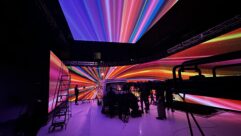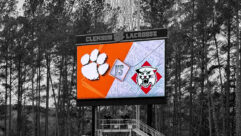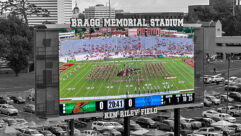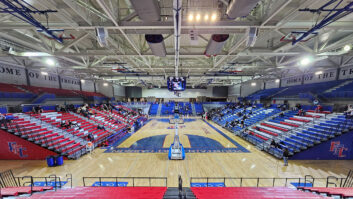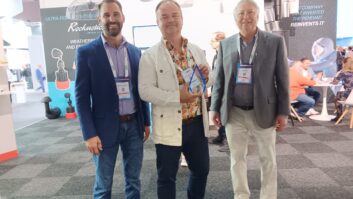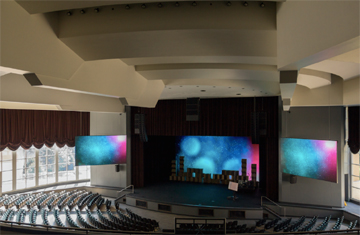
SVC Podcast – Show Notes – Show 169-2
In this edition of the SVC Podcast, Contributing Editor Bennett Liles finishes his talk with Jacob Springman and Zach Kale of Perimeter Church in Johns Creek, Georgia about their move from projection to LED displays in the church sanctuary. NanoLumens CEO Rick Cope provides details on LED display technology and how churches have to learn to create content for large LED displays after making the step up in clarity.
For Part 1
Links of interest:
- Perimeter Church in Johns Creek, Georgia
- NanoLumens, Indoor and Outdoor LED Displays
- Christie Spyder X20 Video Processor
Download Podcast Here:
https://s3.amazonaws.com/nb-svc/public/public/169-2_Perimeter_Church_Nan…
This is the SVC Podcast from Sound & Video Contractor Magazine with Rick Cope of NanoLumens and Jacob Springman and Zach Kale of Perimeter Church. Show notes and equipment links for the podcast are on the web site of Sound & Video Contractor Magazine at svconline.com.
Perimeter Church in Johns Creek, Georgia has moved from projection to LED display technology from NanoLumens. Back for Part 2 are Resident Systems Engineer Jacob Springman and Worship Leader and Venue Director Zach Kale. Also with us is Rick Cope, CEO of NanoLumens. Churches going from projection to LED displays next on the SVC Podcast.
Jacob and Zach, thanks for being back with us for Part 2 on the SVC Podcast from Perimeter Church in Johns Creek, Georgia. We were talking about the installation of new NanoLumens LED displays in the sanctuary. I noticed from the pictures I have that you have the screens on each side of the stage and I think you added one upstage in the center. How do you use that center screen?
Zach: It’s been a challenge because you can do so much with it. Our challenge is really not what can we do, it’s more the question what should we not do? Because the natural inclination in technology with screens when you have new technology put in place is like well, let’s just use it. If you get a new car and it says 180 on the speedometer, it’s like this car goes fast. We should probably take it fast. So the challenge has been just because it has a lot of pixels let’s not use every one of them. Kind of my role as the creative here is to figure out well, is there a way that throughout the service we can tell a story with a screen and not overwhelm you with screen? We don’t want our worship services to feel like Times Square. We want it to feel like an invitation to worship. And so we have succeeded and we’ve failed and we’ve tried different things, and so even the program we’re planning for this upcoming weekend we’re doing so many different things with the screen. Where sometimes it may be a motion background that actually enhances lighting effects or we may do an actual video on the wall of trees moving and it snowing and different things. So we’ve been able to use it as a resource in worship and not just this awesome thing that we can all get tied up and try and make it just as bright and as busy as possible. We’re trying to slow it down a little bit and go all right, how can we use this in a non-taxing way to our eyes? [Timestamp: 2:34]
Jacob, did you have to make any changes to the lighting to accommodate these new LED displays?
Jacob: So as a result of the LED displays we didn’t, but one thing that we noticed as a side effect is actually a lot harder to get beams and haze on the stage now that we have an LED wall behind it because it competes. So that’s just a good thing for people to know, but it hasn’t really been a problem. We’re all right with that. [Timestamp: 2:56]
Yeah, I wouldn’t have thought of that but now that you mention it, once you get all of the effects going and you have live music you could see right through all of the stage effects to that big LED screen in the back.
Jacob: That’s where you have to get creative and go we probably shouldn’t do a white background as we’re trying to move some stuff off of the stage during a quiet moment because you’re going to see every bit of movement. And so it’s figuring out how to get creative and use it as a tool.
Zach: Have it not be distracting.
Jacob: Right. [Timestamp: 3:22]
And we have Rick Cope, CEO of NanoLumens. And Rick, you’ve probably heard this before at Nanolumens. A church gets the new LED display and then they start having to adjust their stage effects so that the LED display doesn’t compete with them. The results can be surprising.
Rick: It is. And then what people like Perimeter have to do is learn how to create the right kind of content for a screen that large. And they’ve done a very good job of it. [Timestamp: 3:47]
Jacob, have you got cameras in the sanctuary of Perimeter Church?
Jacob: Yes. At the moment we have two that are permanently installed. One is a manned camera and the second one is a robotic cam. And wired for up to I think four additional cameras so that for special events, for our Christmas production or Easter we can bring in additional cameras and go in other positions in the auditorium or stage cameras. So the two cameras that are installed permanently are used every single weekend for worship. [Timestamp: 4:15]
And the one that’s manned, is that used mainly for IMAG? Is that the way you use it?
Jacob: Correct. That’s typically our tight-shot for IMAG. And our robotic cameras typically are wide shot or special shot.
When you first got the displays up and tested them, did you notice some things in the image that weren’t that noticeable before? Were there some little warts and moles in the signal that didn’t show up before?
Jacob: Especially in the graphic stuff. We don’t do a ton of video, but yeah the graphic stuff, the way we were getting some of the graphic stuff was through like .jpgs and we’ve had to go no, no, no. We can’t have a lower-quality image. It has to be dialed in right like a .pdf or something like that or it’s going to look blurry on the screen. So it’s going to be crystal clear. [Timestamp: 4:53]
Rick, Do imperfections start showing up in the LED picture that weren’t noticed that much before with the projection? How do they compare on that?
Rick: The LED is so much better that on a projector you can get away with some content that wasn’t that great and no one would notice. But when you put it on a large LED screen the quality differential really jumps out at you. [Timestamp: 5:13]
And Jacob, on taking care of your video investment at Perimeter Church what do you have to do for upkeep on the new LED displays? Is it just keeping them dusted off and that’s about it?
Jacob: There really isn’t. That’s actually one nice feature. There are no fans on the power supplies so there’s no dust being pulled through the units. So really, keep them in an environment where they’re safe and have good power fed to them so you’re not destroying power supplies and otherwise let them go. [Timestamp: 5:39]
Now that they’ve all seen them, what’s been the reaction of the congregation when you unveiled these new NanoLumens LED displays?
Zach: We had a reveal service. The curtains were closed for a couple of weeks, I think, as they were going in. We showed a video and it had some drone footage of, you know, a flyover of the church and the property. You definitely could hear and almost feel the “Oh my gosh,” as soon as they saw them. So they were really excited to have them. [Timestamp: 6:03]
Well, that’s been a new experience and I’m glad you all went ahead with it and I would think that from what I’ve seen that this looks like a trend and more churches are going this way.
Zach: I think so.
Jacob: For sure.
Rick, your company has brought the technology to Perimeter Church and to others so going from here, what else has been happening at NanoLumens?
Rick: We’re still building and designing things here and shipping them to six continents around the world. We’re one of the largest exporters of displays from America to the rest of the world. We just finished an interesting display in the Toronto airport that’s a giant flower. The official flower of the province of Ontario is called a trillium. It’s a three-leaf petal flower. We build a display that looks like a giant flower in Pearson Airport in Ontario and then we coated the underside of the leaves with our material with the flight information. [Timestamp: 6:51]
Incredible. Well that certainly wouldn’t be your average flight information display for sure.
Rick: No. But that’s the kind of things – when we sit down with the customer and we say what were you really trying to achieve? And they said look, the trillium is the flower of the province of Ontario. We want to put a giant trillium here in the terminal but how do we make it useful? [Timestamp: 7:10]
Right, it would be easy to go too far with a gimmick and not have it be real world useful enough. This sounds like you got it right on.
Rick: Now that we have digital wallpaper here at NanoLumens with our flexible, thin and lightweight display that you can wrap anywhere, the ability to build something is only limited by your imagination. [Timestamp: 7:29]
And always coming up not only with technology but new ways to use it for airports, churches and lots more. I know we’ll be seeing NanoLumens again here on the podcast.
Rick: That sounds great. Thank you.
That was Rick Cope, CEO of NanoLumens. Also with us, from Perimeter Church in Johns Creek, Georgia have been Jacob Springman, Resident Systems Engineer, and Zach Kale, Worship Leader and Venue Director. Thanks for being with us guys.
Zach: Thank you.
Jacob: Thank you very much.
Thanks to Jacob Springman and Zach Kale of Perimeter Church and Rick Cope of NanoLumens for joining us on the podcast. Show notes and equipment links are on the website of Sound & Video Contractor Magazine at svconline.com. Be back with us next week for the SVC Podcast.


